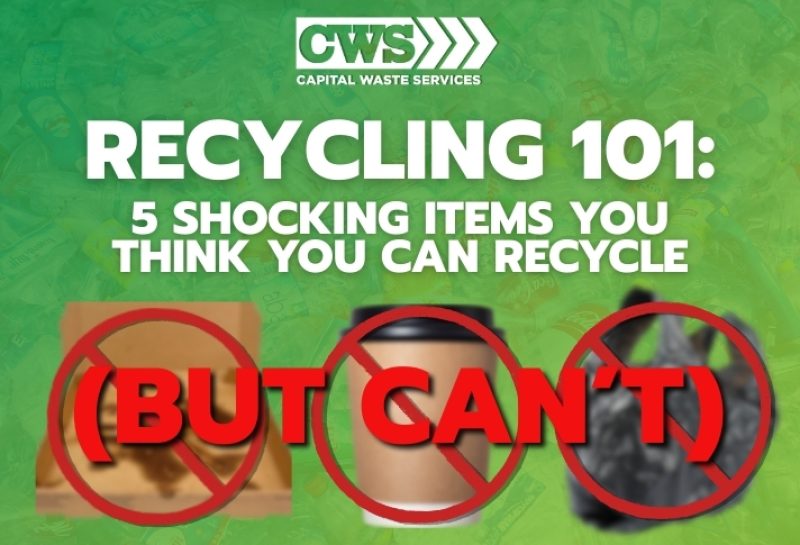
At Capital Waste Services, we’re thrilled that so many of our customers are committed to recycling. Every bottle, can, and piece of clean cardboard you put in the bin makes a difference. But here’s the thing: good intentions aren’t always enough. Recycling contamination happens when non-recyclable items get mixed in with the good stuff, and it’s a big problem. Contaminants can damage processing equipment, increase costs, and sometimes cause an entire truckload of otherwise good recyclables to end up in the landfill.
Some of the most common culprits are everyday items that look recyclable but actually aren’t. If you’ve ever wondered what not to recycle, here are five surprising items that can’t go in your curbside bin and why they belong anywhere but your recycling cart.
1. Pizza Boxes (When They’re Greasy)
We get it, pizza night is sacred. And yes, pizza boxes are made of cardboard, which is normally recyclable. But when that cardboard is soaked in grease, cheese, or sauce, it can’t be processed into new paper products. The oils seep into the paper fibers, weakening them and contaminating entire batches of clean cardboard. Curbside recycling tips: If part of the box is clean (often the top lid), tear it off and recycle it. Toss the greasy portion in the trash or compost it if your community allows for food-soiled cardboard.
2. Plastic Bags
They’re light, they’re everywhere, and they are a nightmare for recycling facilities. Loose plastic bags wrap around conveyor belts and sorting machinery, causing jams, slowdowns, and costly repairs. What to do instead: Reuse them at home or take them to a designated grocery store drop-off location that accepts plastic film. Better yet, skip the single-use bags entirely and go reusable.
3. Disposable Coffee Cups
Morning coffee fuels the day, but your to-go cup might not be as green as you think. Most disposable coffee cups are lined with a thin layer of polyethylene plastic to prevent leaks. That coating is nearly impossible to separate from the paper, which means they can’t be recycled in standard curbside programs. What to do instead: Bring your own reusable mug, or if your area has a specialized program for cup recycling, make sure your cup goes there, not in the curbside bin.
4. Shredded Paper
It seems like shredded paper should be easier to recycle because it’s still paper, just smaller. But those tiny pieces fall through sorting screens, creating litter and making it nearly impossible to process effectively. What to do instead: If you must shred, place the shreds in a clear plastic bag and check with your local facility for drop-off instructions. Some communities have secure shredding events where paper is recycled in bulk without clogging machinery.
5. “Compostable” Plastics
Plates, cups, and utensils labeled as compostable are designed to break down in industrial composting facilities, not recycling plants. In a recycling system, they act like contaminants, mixing in with regular plastics but never breaking down properly. What to do instead: Send them to an industrial compost facility if available. If not, they may need to be thrown away unless your home compost system can handle them, which is rare.
✅ Pro Tip: When in Doubt, Leave It Out
The best recycling is clean recycling. If you’re ever unsure whether something belongs in the bin, check your residential recycling guidelines or call Capital Waste Services for advice. Every time you choose the right place for your waste, you’re helping protect the environment, reduce contamination, and keep recycling programs running efficiently.
Capital Waste Services is proud to provide reliable recycling in the Southeast, and together we can make sure the effort you put into recycling really counts.